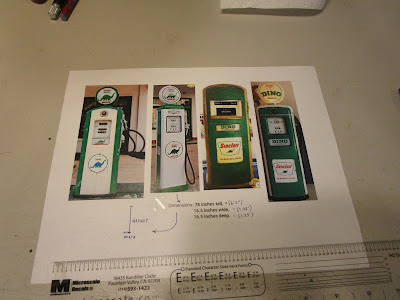Last summer I submitted my twelve scratchbuilt structures for judging. Three earned enough points (87.5) to receive a merit award, and I was told that another two were "very close". I took this news a bit poor, which wasn't the correct response in the situation. However, at the time I was pretty frustrated so I set the models aside and worked on other things. Recently, though, I decided to see if I could upgrade two of the models to help push them over 87.5 point threshold.
Sinclair Gas Station
The only issue with my Sinclair Gas Station model was the over-size pumps. I had scratchbuilt them for fun and when I did it I used tubing sizes I had on hand during the pandemic without much thought as to whether they were 1:87 scale or not. The result was pumps that were closer to S scale (1:64). And, it turns out one of my judges had a father who previously owned a Sinclair gas station, so he was very familiar with the prototypes!
I was told the pumps weren't required to be part of my model because they were separate exterior details, so at the time of judging I asked if I could just rip them off the base and then have it pass. Instead, it was suggested that I replace them. There are several HO scale commercial castings for Sinclair gas pumps that would be suitable, but I wanted to build them myself.
So, after scaling some online pictures I purchased the correct sized styrene shapes and built them again. I also selected a slightly different style of pump. As you can see, the difference in size between the old and new pumps is striking. And the judges were correct... the smaller pumps look much better now.
Big Red Barn
My Big Red Barn project was a bit more challenging. One judge in particular took specific offense to my oversize white trim on the doors and front. I had based my model on a commercial HO scale kit of a barn and never considered that the kit manufacturer didn't properly scale the white trim. And since I thought it looked good so I built it like that. The judges suggested I remove the white trim and rebuild the front wall and doors using thinner scale lumber but my method of construction wouldn't have made that feasible. So, instead I searched the internet for examples of red barns with oversize white trim. And I found some.
The next issue was the fence. Like the gas pumps, it wasn't needed for my model and its original three-board height was so tall that the HO scale horses couldn't stick their heads over it. I had built it without plans and it looked nice, but they were right. Thankfully, it was easy to remove the top horizontal board with a pair of flush cutting pliers. Surprisingly, the rest of the fence stayed intact without breaking. I then touched up the bare wood with some white paint and weathering.
I had also mounted some of the lower windows onto my barn upside down. I never noticed that the castings had a tiny window ledges molded in, so I wasn't careful when I glued them in to make sure the ledge was at the bottom. So, I carefully took a chisel blade and removed the ledges on all of the windows so that they were consistent in style and orientation.
Finally, to earn extra points I added some new scratchbuilt details. I built a hayloft winch with pulley assembly above the hayloft door under the roof eaves; I added a cow water trough and outside plumbing spigots complete with hose; and I fabricated a hay wagon. Everything came out of my scrapbox.
They are just small minor details, but they did add up.







No comments:
Post a Comment